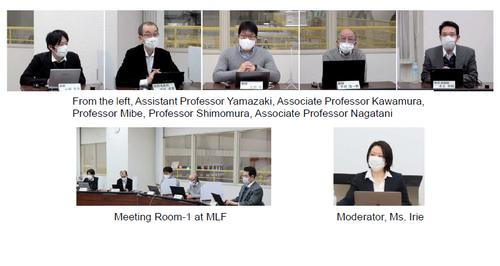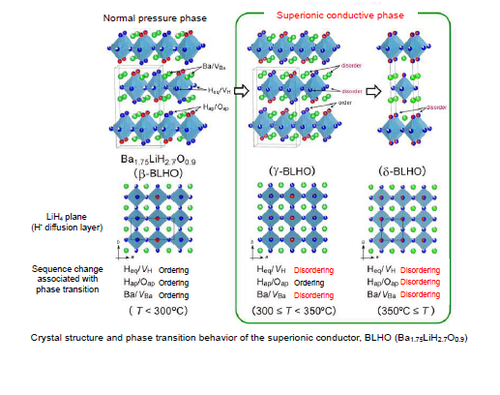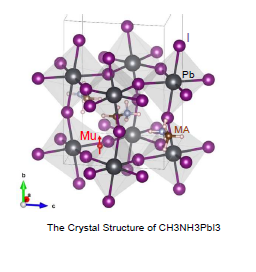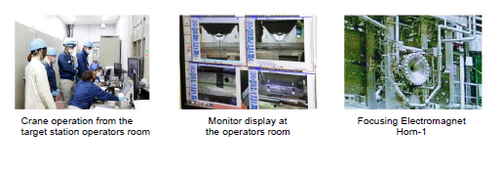J-PARC News February 2022 (Issue #202)
■J-PARC Press Workshop Held (February 8)
Time for dreaming for Ultra Slow Muon Blooms: New Muon Beam Lines Launched for Dual-Purpose Use
In January this year, the first muon beams were delivered to new muon beamlines constructed in the Materials and Life Science Experimental Facility (MLF), where “ultra slow muons”, our new ‘tool’, is going to be used for dual-purpose use of both searching new physics beyond the standard model of elementary particle physics and observing the functions of a living cell as a whole. We provided an opportunity for the press to attend, to explain the science and technology deployed through the use of ultra slow muons, and to answer questions. The online participants included 18 people from 14 media companies. Muon is an elementary particle that is about 200 times heavier than an electron and enables the non-destructive internal observation of pyramids, volcanoes, cultural properties, etc. Using accelerator technology, KEK has developed the ultra slow muon beam whose velocity is decelerated to as low as ten-thousandth of that originating from the accelerator. By aligning the directions and velocities of ultra slow muons and reaccelerating the velocities up to 80 percent of the light speed, we will conduct the g-2/EDM experiment to search for signs of new physics, the high precision spectroscopy experiment on muonium, and the observation using the muon transmission microscope that allows us to examine the inside in greater detail than the electron microscope can do. This time, S2 and H1 areas in the MLF have newly come into operation; accordingly, we have officially launched research using ultra slow muons in various ways.
■Discovery of Hydride Superionic Conductor (Press Release, January 14)
We have for the first time created a superionic conductor in which “hydride (H-)” – a negatively charged hydrogen ion – plays the role of charge transport. The solid-state ionic conductor in which hydrogen diffuses has been used for hydrogen energy devices such as fuel cells. It is generally known that (H+) – a positively charged proton – plays the role of charge transport. On the other hand, if it is possible to apply the H- ion conduction phenomenon with the characteristics suitable for fast ion conduction (e.g., unified ion, appropriate ion radius, and large polarizability) to electrochemistry devices, energy densification can be expected in electricity storage, and high reactivity can be expected to be brought into power generation and material transformation. Associate Professor Genki Kobayashi from the Institute for Molecular Science and others revealed the change in the crystal structure (i.e., phase transition behavior) of BLHO – a superionic conductor – in which H- ion conductivity increases by about 1,000 times, based on the measurement using SPICA and NOVA neutron diffractometers at J-PARC. In this connection, the research of H- conductor is expected to take a new step in the development of electrochemistry devices.
■Mechanism in Which Solar Cell Materials Demonstrate High Efficiency Elucidated: Expectations for Higher-Efficiency and Low-cost Material Development by Utilizing the Observation and Assessment Method Using Muons (Press Release, January 21)
Organic-inorganic hybrid perovskite compounds, which are considered promising next-generation materials for solar cells and are attracting attention as sustainable and renewable energy resources, have structures that contain organic molecules with low symmetrical shapes in perovskite lattices. They are highly efficient in generating power from sunlight, which is considered to be due to the long life of the charge carrier that carries electrical energy in crystalline, but the mechanism had not been known. Dr. Koda (J-PARC Center), Dr. Kadono (KEK) and others examined the relationship between the rotational motion and carrier lifetime of organic molecules by measuring lead iodide methylammonium – a typical element of the compound – by the muon spin rotation (µSR) method using ARTEMIS, J PARC’s general purpose µSR experimental setup. The spins (i.e., characteristics of magnets) of muons point to the same direction at the time of their formation, but their spin directions will be disrupted (called relaxation) in response to the changes in the magnetic field caused by the atomic nuclei in the organic molecules. When the temperature rises, the rotational motion of organic molecules will accelerate due to thermal excitation, thereby averaging the changes in the magnetic field, which prevents muon spin relaxation. The results showed the mechanism that the carrier lifetime will be extended because, when the temperature is low and the rotational speed of organic molecules is at a reasonable rate that allows the relaxation of muon spin, organic molecules with electric dipoles are to move following charge carriers and shielding events in which charge carriers annihilate due to recombination with the positive hole. This result is expected to lead to the development of highly efficient and inexpensive solar cell materials.
■Information
1. The 16th Tokai Forum on February 28: Video to be Released
In order to prevent the spread of COVID-19, the 16th Tokai Forum for reporting on the present and future of the Nuclear Science Research Institute, the Nuclear Fuel Cycle Engineering Laboratories and J-PARC Center will not be held in the form of a face-to-face session plus online distribution; instead a video of the Forum session will be released on Monday, February 28.
Click here to view the video (only available in Japanese): https://www.jaea.go.jp/04/ztokai/forum/index.html
2. Special Exhibition “Elementary Particles Tells US – Mystery of Elementary Particles and Atomic Nuclei Elucidated Using the Second-Generation Particles” held at the Museum of MEXT (February 16 - March 22, Kasumigaseki in Tokyo)
A special exhibition “Elementary Particles Tells US – Mystery of Elementary Particles and Atomic Nuclei Elucidated Using the Second-Generation Particles” has been held at the Museum of MEXT (Ministry of Education, Culture, Sports, Science and Technology). In addition to displaying posters and videos, we display the atomic nucleus and hadron models and distribute spinning tops that allow people to understand about the muon precession while watching a video, etc. You are very welcome to drop in.
For details, please refer to the following article. https://j-parc.jp/c/topics/2022/02/16000832.html
Click here to view the video: https://www.youtube.com/watch?v=LcC-GPFYANQ
(Both only available in Japanese)
 3. The 2nd J-PARC Online Seminar “Variety of Cosmic Substances Made up by Elementary Particle Quarks: J-PARC Endeavoring to Elucidate Them”
3. The 2nd J-PARC Online Seminar “Variety of Cosmic Substances Made up by Elementary Particle Quarks: J-PARC Endeavoring to Elucidate Them”
We would like to clarify the amazing drama of cosmic creation and evolution of substances! We will introduce cutting-edge research using the J-PARC accelerator. The lecturers are Professor Hirokazu Tamura, Department of Physics of Tohoku University and Professor Shinya Sawada, J-PARC Center Particle and Nuclear Physics Division.
YouTube Live Stream is scheduled for March 25, 13:30 - 15:00.
For details, please refer to the following article. https://j-parc.jp/c/information/2022/02/28000836.html
■ J-PARC Hello Science “Producing Lots of Neutrinos and Researching Them, Part II” (January 18)
The lecturer is Dr. Takeshi Nakadaira from the Nuclear and Particle Physics Division, and the lecture will be held online only. At J-PARC, we generate π mesons by hitting as many as 3×1014 protons, which are accelerated up to 30 GeV, to the graphite target. π mesons will decay into muons and µ-neutrinos, and the generated neutrinos will travel through the earth to the Super-Kamiokande, which is 300 kilometers away. During this propagation, some µ-neutrinos will change into electron-neutrinos due to neutrino oscillations. If the probability of change differs in the case of neutrinos and antineutrinos, this is new phenomina called CP violation in leptons.
Moreover, J-PARC is aming to increase neutrino intensity and is currently improving the near detector. As for the T2K experiment, we aim to detect about 200 events of electron-neutrinos appearance and electron-antineutrinos appearance by 2026. Thereafter, in a new experiment using the Hyper-Kamiokande, which is currently under construction, we are planning to observe about 3,000 events for electron neutrinos appearance and electron-antineutrinos appearance, respectively, for a decade from 2027.
■Sanpo-michi #20: Change of Focusing Electromagnet Horn-1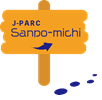
We decided to replace the electromagnetic horn installed at the target station, as part of the improvement associated with the power uprating for the neutrino facility. An electromagnetic horn is for focusing π mesons, which was so named because of its appearance similar to a horn (instrument).
First, the 30-ton shield was lifted by a crane. Then as many as 40 cameras installed in the target station were triggered all at once and displayed the shield on the monitors in the control room. There were always five or more workers in charge in the narrow room, but the actual operation of the crane was carried out by one worker and monitored by the other workers at places for which they are responsible. The crane was carefully operated at a very low speed of five millimeters per second at the time of the removal from the guide cell and of the installation. After several tens of minutes of the motion of such operation that could barely be seen by magnifying the image on the monitor to the maximum, the first electromagnetic horn appeared under the craned support module.
It is said that the electromagnetic horn is the most elegant among many kinds of J-PARC equipment. It has already been eight years since the installation of the electromagnetic horn, which has focused massive π mesons and has itself been activated, but it still glossily reflects the light of mercury lamps on the ceiling and presents a smooth and firm appearance.
The new first electromagnetic horn has already been placed in the target station, and is expected to be installed soon. As a result of the power uprating of the Main Ring and the replacement of the electromagnetic horn with the one that can stand such uprated power, the number of neutrinos that can reach the Super-Kamiokande is expected to increase to two to three times the current one.

